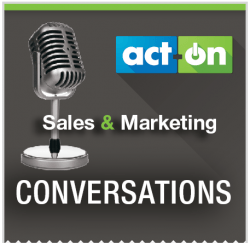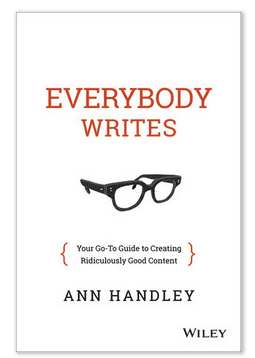 An Act-On Conversation
An Act-On Conversation
Editor’s Note: Ann Handley is the Chief Content Officer of MarketingProfs. She also writes a monthly column for Entrepreneur magazine, and is co-author of the best-selling book on content marketing, Content Rules (Wiley, 2012), which has been translated into nine languages. Ann co-founded ClickZ.com, one of the first sources of interactive marketing news and commentary.
Atri Chatterjee is Act-On’s Chief Marketing Officer. This is the second part of an edited transcript of the Act-On Conversation they held, which you can listen to on the audio player below. If you missed Part 1 of Content Marketing for Small Teams, you can read it here.
How (and where) to promote your content
ATRI: Content creation is not trivial; it requires a lot of thought and effort. When we asked our own customers what their content marketing concerns were, several asked: What’s the best way to promote our content, given how much effort we’ve put into creating this? And, What are the best channels for this?

ANN Looking at the social networks where you are most active, and where your customers are most active or your prospects are most active, is definitely the place to start. I can’t say that there’s one channel that is going to work for every company out there. Because what works for somebody who is interacting quite a bit on Twitter is going to be different than the person who’s on Tumblr or Vine or something like that. So I think it’s important to – as we started this conversation talking about – really know your audience and where they are.
Look also at your own proclivities. Where do you like to talk to people? Your own passion for a network is something that’s important and it’s definitely going to show. But just broadly speaking, I think if you are a B2B company, I would be looking at LinkedIn. I would be spending a lot of time on LinkedIn and SlideShare. Those are two platforms that are vastly undervalued, particularly SlideShare with B2B companies.
In a survey that MarketingProfs does every year with the Content Marketing Institute, we always ask this question: Where are you distributing your content? On what social media sites and social media channels are you distributing your content? And it’s been funny. Consistently every year we’ve seen LinkedIn, Twitter, Facebook. Pretty much one, two, three. But it’s been interesting to see how SlideShare, for example, jumped up in the 2014 report that we did versus 2013. SlideShare can be a very good source of leads for B2B companies.
Another up and coming one – according to our survey anyway, I can’t say I like it personally [LAUGHTER] – but according to our survey, is Google+. There’s a lot of opportunity there. Fifty-five percent of the companies we surveyed on the B2B side in our survey for the 2014 content marketing survey are using Google+. That number surprised me.
ATRI: That is very surprising.
ANN I don’t like Google+ all that much, but clearly it’s something that B2B marketers are really paying attention to.
ATRI: I understand there is a connection between being an author on Google+ and your search rankings, at some level. I don’t know what the latest is on the ranking algorithms, but somehow they all seem to be connected.
ANN Google is a bit of a mystery. I think you get the greatest rewards from Google authorship if you’ve linked your accounts. And Google+ is part of that as well. I can’t say that I’m a search expert or a Google expert, but I suspect that you’re right.
Email’s role in content marketing

ATRI: Social is great; obviously some social channels are more measurable than others, but those are natural place where people go. What about using some of the more traditional things – like email – as a vehicle to share? It seems like a lot of people are still doing that, although perhaps one wants to be careful about overusing a particular medium. Do you have any thoughts on that, in this day and age?
ANN We tend to not talk about email, but it’s a given. You’ve definitely got to have an email program and a database as part of your marketing program. It’s the backbone of what you’re doing in social, on blogs, all across the web. Email is hugely important. It’s also changing a little bit. One of the things that I’ve noticed recently is the idea of sharing content that has a real point of view on email. It used to be that if you were on an industry or company list, the email you got was pretty straightforward.
But now I notice that companies, even in the B2B space, are showing a whole lot more personality on email, which I love. I love the fact that I feel like I’m seeing the human side of a company. And so I think that there are ways that email is being buffed and polished a little bit. It’s still a critical part of your marketing, but at the same time I see companies, especially B2B companies, loosening up a little bit. They’re having some fun with it, and I’m really, really happy to see that. We’re seeing lots of companies who are really oozing with personality with that approach.
We didn’t talk about this, but I want to also mention that with social, you always want to create some sort of call to action to get people more involved in your database, so you can have some sort of a subscription relationship with them. This is truly important.
ATRI: That’s good advice. When we look at our own marketing automation platform, we not only look at sources of leads, but also what influences leads. Content definitely plays a big role in it. People are influenced by things that you’re doing, such as building an interesting email curriculum where you’re sharing valuable information. People start depending on it and they actually look to it. It becomes a factor that influences what their behavior is later on. Once one establishes that, it’s very, very valuable.
How do you know if your content marketing is working?
ATRI: That goes to another question we got. There’s a transformation going on between the branding type of environment to a much more measurable environment. It seems all marketers are becoming (in some sense) direct response marketers. They want to measure things; they want to see how they’re doing. What can you tell our audience about how to measure content, what they should be looking at for benchmarks, and what can they expect? What should they be shooting for in conversion rates and so on?
ANN What kind of conversion rates they should be looking at – that’s a tough question. [LAUGHTER] I think the most important thing is to first define what it is that you’re looking for in a conversion. Are you looking for some sort of sign up? Are you looking to get somebody as a subscriber in your database? Clearly define what that conversion looks like, and stay away from these so-called vanity metrics, likes and shares and comments, things like that.
Although I will say that I do think that metrics like that are useful to at least see what resonates with customers. They aren’t necessarily the measure of how effective your marketing is, but maybe more of a kind of back-of-your-brain kind of reminder that might lead you to say Let’s do some more of that, to drive more engagement or to drive more conversions that way. So first of all, think about the goal of whatever it is that you’re creating. Obviously it’s hard to put a metric around anything until you figure out what it is that you’re trying to accomplish. Then you can build it out from there.
It’s really hard to give general benchmarks about what kind of performance you should be seeing. It all depends on your audience; there are so many factors that go into that.
ATRI: What I’m hearing is there’s probably a way that each marketer can look at their own audience and look at their content and try to codify this. So for example, perhaps your audience is really receptive to “how-to” types of material because you’re in an industry where this sort of education is very important. That would give you a sense of the types of content to keep building. You could measure how that flavor of content is doing compared to another type of content. Overall, you could codify content creation efforts into different categories and see how they’re doing. And then focus more on the categories that are resonating with your audiences.
ANN Exactly. One of the things that I always look for at MarketingProfs is our bounce rate and the average time on page. I want to see whether people are reading more than one article on our website and then leaving, or whether they stick around for a while and consume more of our content. It’s important for me that they stay, that I get them to stay there as long as I can get them to stay there. So I always look at that, and average time on the page.
Those are just my own personal metrics; for me it’s important to have those two.
Again, that’s because I know our audience quite well. Over time I can see how effective our engagement is. It gives me a sense of the quality of things we’re publishing and whether it’s resonating with the people we’re talking to or not.
ATRI: That’s great advice. As simple as it may sound, it’s extremely indicative. If the bounce rate goes down and the average time on page goes up – well, you’re doing something right.
ANN Right, exactly.
ATRI: Ann, thank you so much for joining us. Do you have any closing words of advice? We’d appreciate it.
ANN I think that the most important thing for every business out there to understand is that we all are publishers. We hear that a lot, but I still see a lot of companies who are a little resistant to the notion. Just remember: if you have a website, if you’re on the Internet (which presumably most of us are), that means that you are a publisher. You’ve got to take this content directive seriously. If you’re on social, you’re in marketing. So no matter what you’re doing online, you are a publisher.
So first of all, create the kind of content that your customers want, because it’s an opportunity. I don’t use that word lightly; I do think it’s an incredible opportunity. I want to see more companies take advantage of it, because I believe in its ability to add value. We’ve all seen companies who have tremendous success with it.
So I would just say: Embrace that idea.
Read Part 1 of “Ann Handley and Atri Chatterjee Talk: Content Marketing for Small Teams.“
 In our content-driven world, you, me, and every marketer we know is, in fact, a writer. Preorder Ann’s new book (coming in September) – Everybody Writes: Your Guide to Ridiculously Good Content. This book is is a go-to guide to attracting and retaining customers through stellar online communication. September will be here before you know it! Get your content ready for Q4!
In our content-driven world, you, me, and every marketer we know is, in fact, a writer. Preorder Ann’s new book (coming in September) – Everybody Writes: Your Guide to Ridiculously Good Content. This book is is a go-to guide to attracting and retaining customers through stellar online communication. September will be here before you know it! Get your content ready for Q4!
